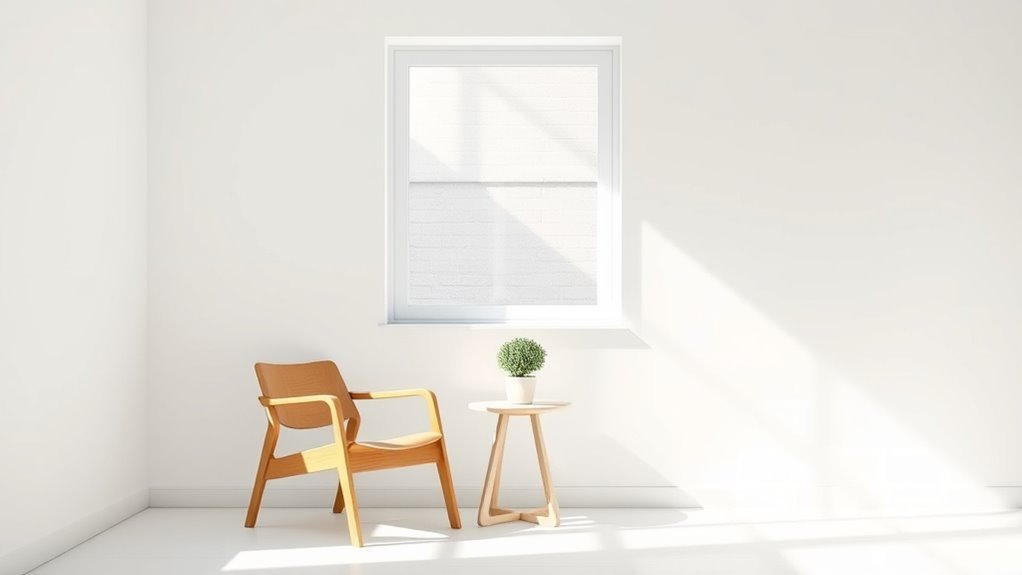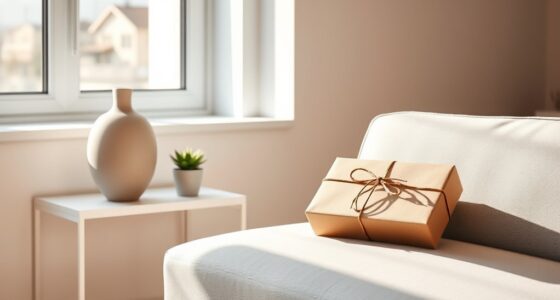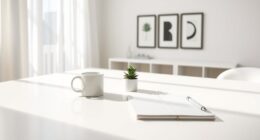Choosing “enough” over “more” helps you create space for what truly matters, both physically and mentally. By setting your minimalist threshold, you stop chasing excess and focus on quality, clarity, and fulfillment. This approach reduces clutter, stress, and distractions, letting you enjoy your possessions and digital spaces more intentionally. Embracing “enough” leads to greater contentment and purpose—so if you want to discover how to define your own threshold, you’re about to learn more.
Key Takeaways
- Recognizing your minimalist threshold fosters intentional living and reduces overwhelm from excess possessions and digital clutter.
- Defining “enough” prioritizes quality over quantity, leading to greater satisfaction and less material dependence.
- Knowing your limits creates physical and mental space, enhancing focus, clarity, and overall well-being.
- Embracing “enough” encourages mindful choices, preventing overaccumulation and promoting contentment.
- Establishing personal thresholds supports sustainable habits, freedom from consumerism, and a more purposeful life.

Have you ever wondered if less truly is more? Embracing simplicity isn’t just about reducing clutter; it’s about creating space for what truly matters. When you set your minimalist threshold, you begin to focus on space optimization—both physical and mental. By trimming down possessions and digital files, you free up room for clarity, purpose, and peace. Digital decluttering becomes an essential part of this process. Clearing out old emails, unused apps, and digital distractions allows you to regain control over your attention and time. It’s not about deprivation but about making intentional choices that serve your well-being. Additionally, understanding the importance of contrast ratio can help you select devices that enhance your visual experience and overall satisfaction.
Understanding your minimalist threshold means recognizing your personal limits for possessions and digital clutter. Instead of chasing after “more,” you define what’s enough. For some, enough might mean a capsule wardrobe that covers all needs without excess. For others, it’s a workspace free from unnecessary items that distract rather than inspire. This threshold isn’t fixed; it evolves as you become more aware of what brings value versus what merely adds noise. When you establish your limits, you prioritize quality over quantity, ensuring that each item or digital space serves a purpose.
Space optimization plays a key role here. When you declutter your environment, you create physical space that’s easier to maintain and more inviting. This not only improves your home’s functionality but also affects your mental landscape. A tidy space reduces stress, enhances focus, and encourages mindfulness. Simultaneously, digital decluttering minimizes the clutter in your online world—unsubscribe from unnecessary newsletters, delete obsolete files, and organize your digital folders. Less digital chaos means fewer distractions and more time for meaningful activities.
Finding your minimalist threshold is about balance. It’s recognizing when enough is enough and resisting the urge to accumulate more. This mindset shift allows you to enjoy what you have, rather than constantly seeking new possessions or digital stimuli. As you refine your limits, you discover that true fulfillment comes from quality experiences and intentional living. You’ll notice that with less clutter—both physical and digital—you can better concentrate on your priorities, nurture your relationships, and pursue passions without distraction.
Ultimately, defining your minimalist threshold empowers you to live intentionally. It’s not about deprivation but about making space—literally and figuratively—for a richer, more focused life. By embracing space optimization and digital decluttering, you create a foundation where “enough” is genuinely enough. This approach fosters contentment, clarity, and a sense of freedom that more possessions or endless digital feeds simply can’t provide. When you understand your threshold, you step into a life that values quality over quantity and purpose over excess.
Frequently Asked Questions
How Do I Determine My Personal Minimalist Threshold?
To determine your personal minimalist threshold, start by reflecting on your personal values and what truly brings you emotional fulfillment. Identify what possessions and commitments support these priorities, and let go of anything that doesn’t align. Pay attention to how you feel when you simplify your life—if you experience more peace and clarity, you’ve found your threshold. Adjust as needed, ensuring your environment supports your well-being and authentic self.
Can Minimalism Apply to Digital Possessions Too?
Did you know the average person spends over 7 hours a day on screens? Minimalism definitely applies to digital possessions too. You can start by digital decluttering—deleting unused apps, organizing files, and reducing notifications. Limiting screen time helps you regain focus and peace. Embracing digital minimalism not only declutters your devices but also creates space for what truly matters, helping you enjoy a more intentional and balanced life.
What Are Common Signs I’ve Reached My Minimalist Threshold?
You know you’ve hit your minimalist threshold when self-reflection reveals you’re no longer emotionally triggered by possessions or clutter. You feel a sense of peace and clarity, not wanting more but appreciating what you have. If you notice that accumulating items no longer brings joy and instead causes stress or guilt, it’s a sign you’ve reached your limit. Trust your feelings and regularly assess your emotional responses to maintain balance.
How Does Minimalism Impact Mental Health?
Imagine your mind as a cluttered attic, filled with emotional clutter and endless distractions. Minimalism clears this space, allowing you to breathe easier and think more clearly. By practicing mindful consumption, you reduce unnecessary worries and stress, leading to improved mental health. With less noise, you can focus on what truly matters, fostering calm, resilience, and a sense of purpose. Minimalism becomes your mental decluttering, creating peace within.
Is There a Timeline for Achieving Minimalism?
There’s no strict timeline to achieve minimalism because it’s a personal journey. You develop a minimalist mindset by gradually setting lifestyle boundaries that suit your needs. Focus on progress, not perfection, and give yourself time to declutter, simplify, and redefine what “enough” means for you. With patience and consistency, minimalism naturally becomes a sustainable lifestyle rather than a deadline to meet.
Conclusion
Now, imagine standing amidst a calm, clutter-free space where every item reflects purpose. When you embrace your minimalist threshold, you create room for clarity and peace, like a gentle breeze sweeping through an open window. Enough becomes your new more—an invitation to savor simplicity rather than chase excess. By defining your threshold, you craft a life where contentment blooms amidst the quiet, leaving behind the noise and embracing the beauty of just enough.









